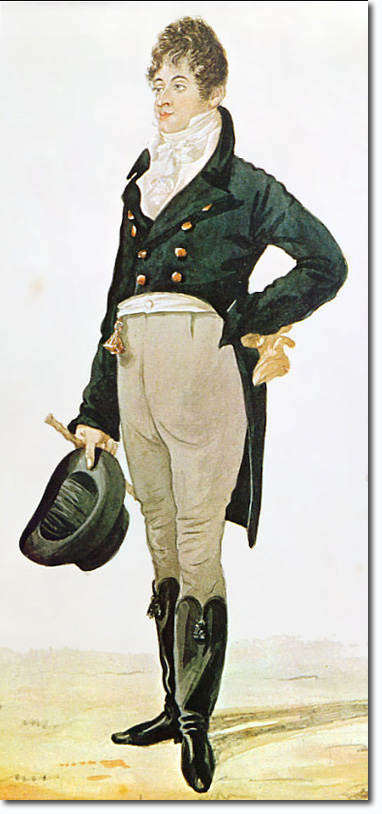|
|


|
|
George Bryan Brummell was born on 7 July 1778. He was the younger son of William Brummell a politician who was ambitious for George to progress up the social ladder. To this end he sent him to Eton where he gained a reputation as a dandy and trend-setter in modes of dress. He was clever and witty, gaining a place at Oriel College Oxford in 1793. But in June 1794, at the age of 16 he purchased his commission in the 10th Light Dragoons as a cornet. Before long an accident with a horse caused his nose to be broken, but this did not dampen his spirits. He was not a natural soldier and did not always feel inclined to attend parades. When he did ride onto the parade ground he only knew which was his Troop because one of his men had a distinctive blue-coloured ‘bottle’ nose. His Troop was the most junior, and when there was a re-organisation it was his Troop that was broken up and the men dispersed among the others. Brummell, being unaware of this came on parade and at first could not find his Troop. Then he caught sight of ‘bottle’ nose and placed himself in front. The CO called out, “How now, Mr Brummell, you are with the wrong Troop.” Turning around in his saddle to check the position of ‘bottle’ nose, George said, “I know better than that. A pretty thing indeed if I did not know my own men.” He had an inheritance from his father of 21,600 pounds which in a rich regiment like the 10th was not enough to pay mess bills and buy expensive uniforms. In 1896 the 10th, after having been stationed in the south of England for 13 years, was ordered to Manchester. Brummell claimed that he could not possibly go on foreign service and sold his captaincy.
Beau Brummell is less famous for his military service than for his role in society as a fashion icon, and for his friendship with the Prince of Wales. He was instrumental in changing how London gentlemen dressed. The turn of the century was the ideal time to ditch the 18th century ideas of dress and bring in a new style. The high necked turned-up white shirt collar with white cravat was his innovation. He also changed the fashion of knee breeches and stockings for full-length trousers. Top hats replaced bi-corns, and waist-lines were raised. His witty remarks often got him into trouble but he felt safe enough under the wing of the Prince of Wales. The Prince, like other aristocrats, studied Brummell’s style, and were, thankfully, also influenced by his insistence on personal cleanliness. However his debts were mounting up and he fell out with the Prince by 1813. When Brummel was ‘cut’ by His Royal Highness at a club, he turned to Lord Alvanley and said, “Alvanley, who’s your fat friend?” Oddly, this was not the end of the Beau’s social life. He managed to carry on until 1816 when he had to flee the country to avoid debtor’s prison. His friends secured a place for him at the consulate in Caen but his life deteriorated so that he was far from a dandy, and at one point was imprisoned for debt in France. His friends once more bailed him out but his decline continued so that on 30 Mar 1840 he died penniless and mad from syphilis in a French asylum near Caen. The film still comes from ‘Beau Brummell’ released in 1954 (in colour). Stewart Granger played Brummell, here confronting Peter Ustinov as the Prince, and a seated Elizabeth Taylor. They made an effort with the uniforms, although the epaulettes are wrong and the sleeved jacket slung on the shoulder is wrong. |

|
Armed Forces | Art and Culture | Articles | Biographies | Colonies | Discussion | Glossary | Home | Library | Links | Map Room | Sources and Media | Science and Technology | Search | Student Zone | Timelines | TV & Film | Wargames